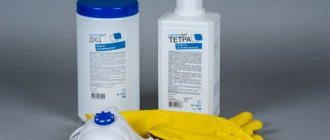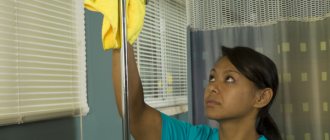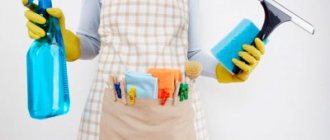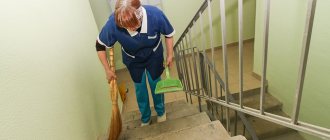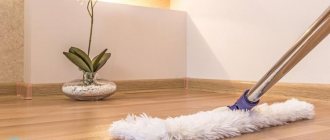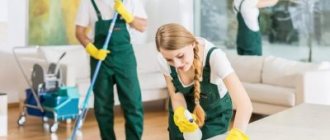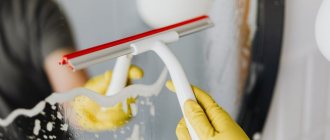Cleaning in medical organizations is necessary to prevent the spread of infectious disease pathogens through various surfaces. By touching a table or door handle, a person (patient or clinic staff) leaves bacteria or viruses there, and in return acquires new “passengers.” Thus, infectious agents quickly spread not only throughout the territory of the treatment and prevention organization, but also beyond its borders (public transport, pharmacies, shops, houses and apartments of patients and staff, etc.).
Due to the presence of an underlying disease, patients in clinics of various profiles are more vulnerable to infectious agents than healthy people. Therefore, cleaning in a medical organization is a special responsibility that falls on the shoulders of the staff.
The requirements for cleaning in medical organizations are set out in the sanitary and epidemiological rules SanPiN 2.1.3.2630-10 “Sanitary and epidemiological requirements for organizations engaged in medical activities” (hereinafter referred to as SanPiN 2.1.3.2630-10).
Types of cleaning in medical organizations
A division of cleaning into routine and general cleaning is provided.
Routine cleaning means wet cleaning of premises (cleaning floors, furniture, equipment, window sills, doors) at least 2 times a day using detergents and disinfectants approved for use in the prescribed manner (clause 11.1 of section 1 of SanPiN 2.1.3.2630-10 ).
General cleaning is also carried out using detergents and disinfectants. In this case, not only floors, furniture, equipment, window sills, doors are processed, but also walls, equipment and lamps. The frequency of general cleaning is once a week in rooms with an aseptic regime (operating unit, dressing rooms, delivery rooms, treatment rooms, manipulation rooms, sterilization rooms, etc.) and at least once a month in other rooms. In addition, outside the schedule, general cleaning is carried out when unsatisfactory results of microbial contamination of the external environment are obtained and for epidemiological indications.
Another difference between general cleaning and current cleaning is the mode of use of disinfectants. Thus, current cleaning is carried out according to regimes that ensure the death of bacterial microflora, and only in case of contamination of objects with blood and other biological substrates - according to an antiviral regime. When carrying out general cleaning, disinfectants with a wide spectrum of action are always used in modes that ensure the death of bacteria, viruses and fungi. The exceptions are ward departments, doctors' offices, administrative and utility rooms, departments and rooms of physiotherapy and functional diagnostics, where even during general cleaning, disinfectants are used according to regimes that ensure the death of bacterial microflora.
Cleaning surfaces during general cleaning
Floor cleaning is carried out with specialized and highly active detergents containing disinfectants.
Floor treatment can be done with or without treatment exposure. Depending on internal requirements, certain cleaning agents are used; in some cases, completely environmentally friendly products can be used.
Cleaning and washing walls is carried out in the same way as cleaning floors, despite the less contaminated surface. For these purposes, the same disinfectants are used, based on detergents and non-detergents. Cleaning requirements may be established within the internal regulations in accordance with sanitary standards.
Glass cleaning is usually carried out using specialized care products and tools, but steam generating devices are more effective. With their help, you can not only remove all dirt, but also clean without streaks.
Requirements for disinfection of premises are established by existing standards and internal regulations for cleaning procedures. Typically, detergents are used for these purposes, which are used for cleaning at food group enterprises and in public catering.
Requirements for the uniform of cleaners are established by the standards of sanitary and epidemiological stations. Please note that after cleaning, the entire instrument must be processed and cleaned. It is treated with steam or special means.
Air purification in some food plants has already become the norm. This is usually done using an air conditioning unit that traps pollutants, viruses and bacteria. The same effect can be achieved using an industrial separator vacuum cleaner.
The use of detergents or steam is a dilemma for many businesses, as steam cleaning is not covered in sanitation standards. Moreover, it can be used along with recommended detergents.
Effective cleaning of premises of medical organizations
What needs to be done to ensure that cleaning the premises of medical organizations is effective?
Firstly, ensure the integrity of the hygienic coating of the surfaces being treated. That is, the surfaces of walls, floors, ceilings, furniture, equipment, heating devices, etc. should not have chips, crevices, cracks, other mechanical damage, signs of corrosion, etc. Their surface must be smooth, preventing the adsorption of dust (clause 4.2 of section 1 of SanPiN 2.1.3.2630-10).
Secondly, the covering of floors, walls, ceilings, furniture, equipment, heating devices, etc. must be made of materials that are resistant to treatment with detergents and disinfectants (clause 4.2 of section 1 of SanPiN 2.1.3.2630-10).
Thirdly, it is necessary to place furniture and equipment in the premises in such a way that all surfaces are easily accessible during cleaning (clauses 6.2 and 8.2 of section 1 of SanPiN 2.1.3.2630-10).
Fourthly, choose the right detergents and disinfectants, ensure their proper storage and preparation of working solutions (clauses 11.1–11.4 of section 1 of SanPiN 2.1.3.2630-10).
Fifthly, allocate a sufficient amount of cleaning equipment, ensure its marking and storage (clauses 11.5, 11.11 of section 1 of SanPiN 2.1.3.2630-10).
Sixth, train personnel in the technique and frequency of routine and general cleaning (clause 11.1 of section 1 of SanPiN 2.1.3.2630-10).
Step by step plan
Where to begin.
Start with the furthest rooms, gradually moving towards the hallway and bathroom. In each room:
- Disassemble cabinets, closets, mezzanines, balconies - throw away old trash, unnecessary things and broken items.
- Remove blinds and curtains and shake off dust. Wash curtains and drapes.
- Use a broom, broom or dusting brush to remove dust along the ceiling and corners of the walls.
- Wipe down lampshades, chandeliers, cornices and doors.
- Wash windows and radiators.
- Vacuum, fold the carpet and put it away.
Cleaning the bedroom and living room.
Here you need to pay attention to cleaning things and cleaning furniture. How to organize your closets and chests of drawers:
- Remove all items from the shelves.
- Wipe the shelves with a damp cloth and let dry.
- Give things you don't need to friends or charities.
- Carefully lay out and hang the remaining clothes.
- You can put an aromatic sachet on the shelves.
Use the same method to clean out bookcases and nightstands. Wash bedding, bedspreads, curtains and vacuum the sofa. Wipe dust from all surfaces, polish furniture and wash the floor.
Kitchen.
List of works:
- Using special means, clean the stove, oven, refrigerator, microwave and hood from grease and carbon deposits. Heavy dirt can be removed with soda or Pemolux.
- Remove the ventilation grille and lampshade and soak in soapy water.
- Boil a kettle with citric acid to remove scale.
- Wash the windows and windowsill.
- Wash curtains, tablecloths, oven mitts and oven mitts.
Hallway.
Shake out the door mat and wipe the door on both sides. Tidy up your shoe rack, bedside table, hangers, mirrors. Wash the floors with a cleaner, especially at the entrance and under the shoe racks.
Bathroom and toilet.
Spray the bathtub, sink, toilet and tiles with the cleaner and leave for 15-20 minutes. Clean up your cabinets and shelves: throw away empty or expired bottles, jars and bottles. Then wash the fixtures and walls, as well as the mirrors and floors.
The final stage.
At the end of cleaning, wash the floors throughout the house. Hang curtains and drapes while they are damp to avoid wasting time ironing. Place carpets, bedspreads and pillows on beds, sofas, and chairs. Be sure to ventilate the apartment.
Handling and storage of cleaning equipment
Maintenance of cleaning equipment is an integral part of the cleaning process and includes washing and disinfection, as well as proper storage of clean equipment. Poorly treated rags, cleaning containers and mops accumulate microorganisms and themselves become factors in the transmission of infection.
Sanitary rules SanPiN 2.1.3.2630-10 (clause 11.5 of section 1) provide for the possibility of processing mops and rags in washing machines specially designated for these purposes, which are installed in places where cleaning carts are assembled.
A separate room must be allocated for storing cleaning equipment (clause 11.5 of section 1 of SanPiN 2.1.3.2630-10), equipped with racks or other devices for fixed storage of mops, containers and rags.
Thus, the cleaning process is one of the key links in the prevention of nosocomial infection. Despite the ordinary nature of the cleaning process, medical organizations face significant difficulties in organizing it. Solving these problems is possible with an integrated approach and the development of step-by-step algorithms and visual instructions for personnel performing cleaning and maintaining cleaning equipment in each specific medical organization.
Means and tools
The quality of hospital disinfection largely depends on the proper selection of equipment and cleaning products. Within a medical institution, you can encounter not only the presence of ordinary dirt and household dust, but also bacteria, viruses, and other pathogenic microorganisms that can become sources of various infections.
Bucketless cleaning in a medical institution, in which a nurse simply wipes horizontal surfaces with a damp cloth, is unacceptable. It is imperative to use professional equipment and products with powerful bactericidal and antifungal effects. The administration of the institution must provide the employee with full equipment. It includes:
- a set of protective clothing (robe, rubber shoes, cap, gloves, respirator, goggles);
- containers in which concentrates will be diluted, buckets for clean water;
- mop, battery brushes, rags and rags;
- disinfectant solutions;
- detergents.
Each item has its own marking. The equipment is sterilized before use. It is stored in a specially designated place. It is used only in those premises for which it was originally intended. The mop used to clean the floors in the toilet will never be used to clean the floors in the rooms where patients are lying.
Concept of current disinfection
The term “current disinfection” refers to the cleansing of the area where the infection has spread. The purpose of this procedure is to destroy the source of the disease (causative agent).
Indications for the implementation of measures are:
- the patient’s presence in the source of infection until hospitalization;
- outpatient therapy of an infectious patient;
- in a situation where the sick person releases bacteria into the external environment (coughing, saliva, sneezing) until complete recovery;
- stay in the apartment of a convalescent (patient in the recovery stage) until deregistration at the tuberculosis dispensary.
Disinfection is organized by a specially trained medical worker who has identified an infectious patient, as well as sanitary and epidemiological control services. The role of the medical staff is to convey to the patient how to daily disinfect the place of residence.
There are several groups of measures for ongoing disinfection:
- sanitary and hygienic works;
- application of measures to disinfect environmental objects and physiological secretions of the patient.
Current disinfection is carried out by relatives living with the patient.
Cleaning plan after renovation work
Apartment renovation always involves a lot of garbage, so high-quality cleaning is a necessity. It takes a lot of effort and time to complete the task, but, alas, there is no other way. Of course, there are many cleaning companies involved in cleaning premises that will quickly and efficiently complete all the work, but this requires significant costs. Therefore, in order to save budget funds, it is quite possible to cope with cleaning after repairs on your own.
The main thing is to act according to a pre-made plan
- Remove large construction debris. To begin, put on protective equipment, including safety glasses, rubber or cotton gloves and overalls. Further, it is better to bundle waste such as wallpaper into a separate roll to save space in bags. The rest of the bulky waste is placed in bags. Then sweep the floor and take the bags of garbage to the landfill.
- Wash the walls, ceiling and floors. After taking out the trash, it's time to start cleaning all surfaces. First, take a vacuum cleaner and collect all the dust. If there is a washing model, this will reduce the time it takes to clean the room, since it will perform two types of work at once.
- We clean furniture and other interior items. As a rule, before starting repair work, all furniture is covered with plastic film, but even such a coating cannot provide complete protection. To clean upholstered furniture, it is recommended to use a swab dipped in milk. It is able to cope with minor dirt in the form of stains.
- We wash glass and mirrors. To do this, use sponges, rags and special products that are designed for these purposes. It is worth remembering that washing windows in a multi-storey building is not safe, and therefore requires the hiring of qualified workers equipped with special equipment and equipment.
- At the final stage, you need to wash the remaining items and accessories: lampshades, radiators, sconces and others.
In some cases, the use of chemicals such as solvents is acceptable. In other cases, use regular cleaning products.
Registration logs for current cleaning
The log of current cleanings includes an approved schedule for their implementation. After cleaning, a recording is made. The log indicates the planned date and time, actual data, who carried out the cleaning, what detergent was used, the disinfectant solution, its quantity and concentration. This must be followed by the name of the person who controlled the process and effectiveness. Paintings are put up of those who did and supervised the cleaning.
A regulatory document is drawn up separately, which indicates the number of cleanings for each specific type of room and lists individual rooms for which there is a personal schedule.

